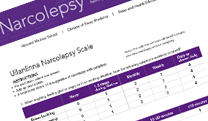The Takeway
- Sleepiness can occur for a variety of reasons, but persistent sleepiness that occurs even after a good night’s sleep is usually the first clue that someone may have narcolepsy.
- Self-assessment tools on this website can help identify problematic sleepiness and symptoms of narcolepsy.
Most strikingly, it wasn't just sleepiness in boring classes or in car rides—relatively mundane things. She was actually falling asleep during her fun activities.
-Dr. Kiran Maski on diagnosing Liza
While sleepiness can occur for a variety of reasons, persistent sleepiness is usually the first clue that someone may have narcolepsy. To help identify problematic sleepiness, ask yourself these questions:

- “Once you have caught up on your sleep during weekends or vacation, are you still likely to fall asleep when inactive?”
- “Do you feel rested in the morning but then tired throughout much of the day?”
- “Do you doze off at inappropriate times?”
If you answered “yes” to any of these questions, you should discuss your sleepiness with your primary care physician or sleep specialist.
Dream-like hallucinations just prior to sleep, and sleep paralysis at times when you are awake, are suggestive of narcolepsy. However, these symptoms are not considered very specific for the disorder, as they can occur in people who simply need more sleep. In contrast, true cataplexy is very distinct and occurs almost exclusively in narcolepsy.
Dr. Kirsch notes some reasons why narcolepsy may go undetected in teenagers.
Helpful tools
About 1 in 2,000 people have narcolepsy, but it may go unrecognized for years by individuals and their doctors. Sleepiness is often overlooked or just brushed off as a part of life. In addition, most primary care physicians and pediatricians are unfamiliar with how to recognize and treat narcolepsy. One helpful self-assessment tool for recognizing sleepiness is the Epworth Sleepiness Scale (ESS). You can measure your daytime sleepiness using a printed version of the ESS (PDF) or the online version of this screening tool. An ESS score higher than 10 indicates troublesome sleepiness, and many people with narcolepsy have scores higher than 15.1
The Ullanlinna Narcolepsy Scale (named after the clinic in Finland where it was developed) is also a well-validated questionnaire for diagnosing narcolepsy with cataplexy. Print out the Ullanlinna Narcolepsy Scale (PDF) to assess your symptoms.

If you suspect you have narcolepsy, discuss your concerns with a medical professional familiar with narcolepsy and other sleep disorders. See the Finding a Doctor section of this website for more information on finding a sleep specialist.
References
- Johns MW. A new method for measuring daytime sleepiness: the Epworth sleepiness scale. Sleep 1991; 14:540–5.
back to Narcolepsy Home